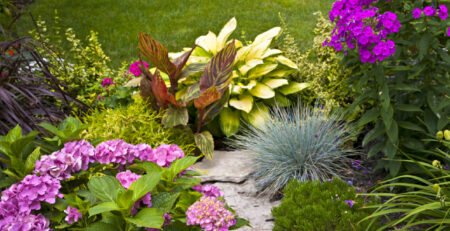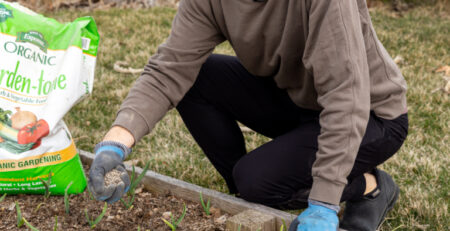Guide: Planting Summer Bulbs
Summer Bulbs Bring Summer Color
Summer-flowering bulbs pack powerful punches of color during the middle months. Unlike spring bulbs that are planted in the fall, summer bulbs are planted in the spring for summer growth. They’re considered tender perennials, meaning they can’t survive the cold. Typically, they’re either grown as annuals or they’re dug up and stored for the winter to be planted again the next spring. Summer bulbs need warm weather and warm soil, so the end of May is a perfect time to plant.
When planting bulbs, a general rule is to plant them about three times as deep as their diameter. For example, a 2″ bulb needs a hole that’s 6″ deep. Check the bulb packages for planting depths. Some bulbs, like dahlias, require larger planting holes. For a more natural look, plant bulbs in clusters. Try tossing them on the ground and planting them where they fall. While you plant, mix compost with your soil for added nutrients. You should also mix in high-phosphorous bulb fertilizer into the planting hole to give roots an added boost. Plant bulbs pointed side up, root side down; if you can’t tell which one’s which, plant the bulb sideways. Once in the ground, water bulbs thoroughly and continue to do so, but let the soil dry out in between watering.

Keep the area weed-free. Not only do they reduce the aesthetic aspect of your garden, but they also compete with your plants for nutrients, and they often win. Protect your bulbs even further—squirrels and other critters love digging up freshly-planted bulbs, so lay a layer of mulch down to hide the planting holes.
If grown as annuals, fertilizing bulbs isn’t absolutely necessary, but a dose mid-summer will be beneficial. If you are storing them over the winter, feed every month during the growing season.
Storing Bulbs for the Winter
If you’re planning to keep your bulbs for next summer, here are a few storing tips to keep them viable.
- When the foliage dies, clear it away and dig up the bulbs.
- Let the bulbs dry out in a sheltered, frost-free location.
- Once they’re dry, store them in a plastic container with a tight-fitting lid.
- Add a layer of dry material, such as vermiculite, sand, peat moss, or newspaper, to the container.
- Layer the bulbs, but don’t let them touch each other.
- Add a second layer of dry material and continue until you’ve filled the container or stored all your bulbs.
- Check over the winter to make sure no bulbs are rotting or developing soft spots.
- Come late winter or early spring, pot everything in temporary containers and let them begin growing.
- Once the danger of frost has passed, plant your grown bulbs outside and maintain normally.










